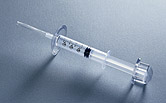
FRIDAY, Feb. 8 (HealthDay News) — Researchers have documented a startling rise in the rate of type 1 diabetes in one city: Diagnoses in kids younger than 5 jumped by 70 percent between 1985 and 2004 in Philadelphia.
Overall, the rate of type 1 diabetes in children aged 14 and younger climbed by nearly 30 percent during that time period, according to the study.
“We have demonstrated a significant increase of type 1 diabetes over time, particularly in children under the age of 5 years old,” said study author Terri Lipman, a professor at the University of Pennsylvania School of Nursing in Philadelphia.
“Whatever is driving the increase of type 1 diabetes in general, it appears the youngest children are the most susceptible,” said Lipman.
Results of the study were published online recently in the journal Diabetes Care.
With type 1 diabetes, the body does not produce enough insulin, and patients need insulin injections to survive. It usually begins earlier in life than type 2 diabetes, which is much more common and may or may not require insulin therapy. Type 2 diabetes is associated with obesity and a sedentary lifestyle, whereas in type 1 an environmental trigger causes the body’s immune system to mistakenly attack the insulin-producing cells in the pancreas, eventually destroying them.
According to U.S. Centers for Disease Control and Prevention estimates, if current trends continue, the rates of type 1 will increase by 23 percent by 2050.
The United States isn’t the only country experiencing this growth in type 1.
“Whether you look at Europe, Canada, Australia or the U.S., type 1 diabetes in youth is increasing. And some of the largest increases are in the youngest age group,” said Dr. Richard Insel, chief scientific officer for JDRF (formerly the Juvenile Diabetes Research Foundation).
What isn’t clear is what specifically is driving this increase. Numerous theories abound, but none has yet been proven. Because the incidence is increasing so rapidly, Lipman and Insel said it must be in the environment.
“Obviously it’s something in the environment that has changed the threshold for this disease. Where we see the fastest growing rates of type 1 diabetes is in areas of rapid modernization, like in Eastern Europe, around the fall of the Iron Curtain,” said Insel.
Lipman and her colleagues began collecting data on Philadelphia-area children and their rates of type 1 diabetes in 1985. Of 322,998 children 14 years old and younger living in the city between 2000 and 2004, the researchers said 277 children were newly diagnosed with type 1 diabetes.
Overall, this represents a 29 percent increase in the rate of newly diagnosed type 1, according to the study.
When they broke the data down by age groups, they saw a surprising 70 percent increase in the rate of type 1 in children up to age 4.
The other striking finding was that in white and Hispanic children, the incidence of type 1 diabetes jumped dramatically from the 1995 to 1999 study period to the 2000 to 2004 period. The rates of type 1 went up 27 percent in Hispanic kids and 48 percent in white children in that short time period.
The incidence of type 1 in black children actually dropped slightly between the 1995 and 2000 study periods, but overall rose 2.3 percent a year from the 1985 study time period to the 2000 time period. And when the researchers looked at only young black children — those 5 and younger — they saw a threefold increase in the incidence of type 1 diabetes between the 1985 and 2000 study periods.
It can be difficult to diagnose type 1 diabetes in the youngest children because they can’t always talk about how they’re feeling. Extreme thirst and frequent urination are two common signs of untreated type 1 diabetes.
Lipman said that if your child is suddenly extremely fussy, soaking more diapers than normal, can’t seem to get enough to drink, the pediatrician should test for diabetes. Likewise, if your child is dehydrated, the pediatrician should check for type 1 diabetes. A child who’s 3, 4, or 5 years old — or even older — and toilet-trained who suddenly starts having urinary accidents or wetting the bed should be evaluated for type 1 diabetes. Lipman added that the initial evaluation for type 1 consists of checking the urine for sugar, so it’s a painless test.
Insel added that children with undiagnosed type 1 may also have a fruity smell on their breath, and they may breathe heavily. He said sometimes they’re misdiagnosed as having a breathing disorder.
More information
To learn more about type 1 diabetes, including the warning signs of type 1, visit JDRF.

